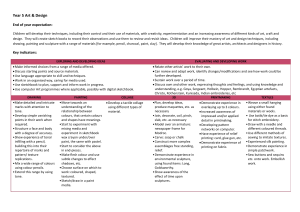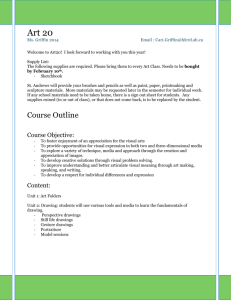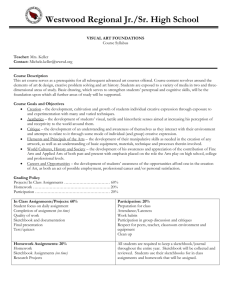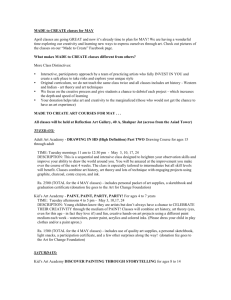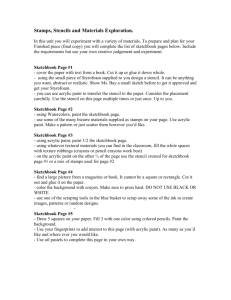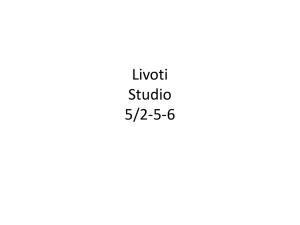Abstract Art II (IM)
advertisement
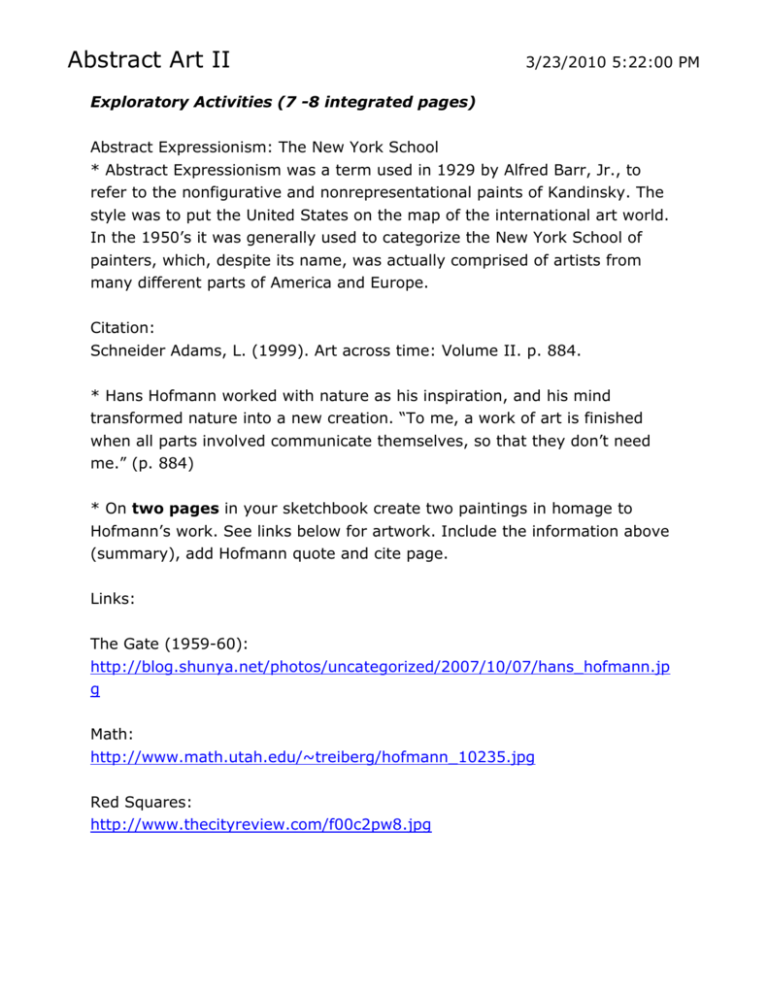
Abstract Art II 3/23/2010 5:22:00 PM Exploratory Activities (7 -8 integrated pages) Abstract Expressionism: The New York School * Abstract Expressionism was a term used in 1929 by Alfred Barr, Jr., to refer to the nonfigurative and nonrepresentational paints of Kandinsky. The style was to put the United States on the map of the international art world. In the 1950’s it was generally used to categorize the New York School of painters, which, despite its name, was actually comprised of artists from many different parts of America and Europe. Citation: Schneider Adams, L. (1999). Art across time: Volume II. p. 884. * Hans Hofmann worked with nature as his inspiration, and his mind transformed nature into a new creation. “To me, a work of art is finished when all parts involved communicate themselves, so that they don’t need me.” (p. 884) * On two pages in your sketchbook create two paintings in homage to Hofmann’s work. See links below for artwork. Include the information above (summary), add Hofmann quote and cite page. Links: The Gate (1959-60): http://blog.shunya.net/photos/uncategorized/2007/10/07/hans_hofmann.jp g Math: http://www.math.utah.edu/~treiberg/hofmann_10235.jpg Red Squares: http://www.thecityreview.com/f00c2pw8.jpg * On two pages in your sketchbook read and examine the work of Helen Frankenthaler. She was considered an action painter; used synthetic media to satin her canvas by pouring paint directly onto it. Create images by pouring paint – use watercolor of diluted acrylic. Summarize the history notes and cite the source. History Notes: http://en.wikipedia.org/wiki/Helen_Frankenthaler Images: The Bay, 1963 http://3.bp.blogspot.com/_zuxC1XIxM1Q/SStp5_uGU6I/AAAAAAAAAIU/9up4V0IRqM/s400/HelenFrankenthaler.jpg The Sea http://www.ebsqart.com/zine/2003/200304/pics/rsea.jpg Seeing the moon on a hot summer day http://www.artinthepicture.com/artists/Helen_Frankenthaler/moon.jpeg * On three pages in your sketchbook respond to the video: Abstract Painting by Lindsey Cormier. Watch the video. Paint three pages in your sketchbook with tempera cakes, watercolor or acrylic paints. Use dark colors for each page (purple, blue, black). On each page use a different shape in the style of Lindsey Cormier. Overlap, let the paint drip, mix colors, etc. Experiment with the expressive nature of the process. On each page write some ‘visual thinking/process notes’ that describe you thinking during the painting. Video Link: http://www.youtube.com/watch?v=Fq1-NsFrbs4&feature=related Abstract Art II 3/23/2010 5:22:00 PM Conceptual Activities = 7 to 8 pages (not integrated) * How can you create something that is unique? A personal response? The development of ‘Ideation’? One way of beginning to understand what is going on in a work of art is to try to grasp its content – its meaning, including the subject-matter (what it is or represents), and the emotions, ideas, symbols, stories, or spiritual connotations it suggests. On two pages in your sketchbook examine the art of Lena Karpinsky. See link below for her online gallery. Create a triptych on both pages or just create a section that has inspired you to paint or use oil pastels. Do not copy these images; use them as inspiration and for studying the technical aspects of the composition. Link: http://www.artbylena.com/ * On three pages in your sketchbook examine the abstract drawings by Lynne Taetzsch. See link below to view gallery 3. Link: http://www.artbylt.com/modern-paintings-gallery3.htm * On three pages in your sketchbook examine the video link below for Art Gems. Create three images from this slide show. Link: http://www.youtube.com/watch?v=fP6SZRsa5FE Abstract Art II 3/23/2010 5:22:00 PM Reflection Activities: 5 pages (integrated) What is so interesting about the artists, artwork, or art style? This section we will compare and contrast images we find engaging. We will also use this section to do some self-reflection on our own art creations. On one page in your sketchbook explain why this image below is called Popsicle. Print out a color image and describe how you would go about creating this painting. Link: http://intelligenttravel.typepad.com/photos/uncategorized/2008/02/13/2237 262765_be6fbb1a45.jpg On one page in your sketchbook print out this abstract painting by ‘Frank”. Look at the information to the right to examine color palette, size, medium, and cost. Glue in the copy of the image and describe how the artist created this painting, discuss the information on the right of the image and rationalize why this piece of art cost $200. Link: http://fineartamerica.com/featured/4-abstract-painting-frank.html Using the rubrics below select one of your paintings from the conceptual section to critique. Use one page. CATEGORY 5 4-3 2 1 Sco Design/Composition Student applies design principles (such as unity, contrast, balance, movement, direction, emphasis, and center of interest) with great skill. Student applies design principles (such as unity, contrast, balance, movement, direction, emphasis, and center of interest) with fair skill. Student tries to apply design principles (such as unity, contrast, balance, movement, direction, emphasis, and center of interest) but the overall result is not pleasing. The student does not appear to be able to apply most design principles to his/her own work. Color Choices Choice and application of color shows an advanced knowledge of color relationships. Color choice enhances the idea being expressed. Choice and application of color shows knowledge of color relationships. Colors are appropriate for the idea being expressed. Choice and application of color shows knowledge of color relationships. Colors are, however, NOT appropriate for the idea being expressed. Student needs to work on learning color relationships and using that knowledge in his/her work. Painting Skill Application of paint is preplanned and done in a logical, sequential manner. Paint is applied in a careful, logical manner. Colors remain sharp and texture is evident. Control is somewhat lacking. A few drips, ragged edges and failure of certain areas of pattern/texture may be evident. Student needs to work on controlling paint and preplanning paint application. Muddy colors, ragged edges, lack of texture, drips and/or blobs are evident throughout the painting. Use of materials Student typically keeps painting materials and area clean and protected without reminders. The student shows great respect for the materials and his fellow students. Student typically adequately cleans materials and work area at the end of the session without reminder, but the area may be messy during the work session. Student shows respect for Student adequately cleans and takes care of materials if reminded. Occasional spills and messy work area may be seen. Shows some respect for materials and fellow students. materials and Student deliberately misuses materials AND/OR does not adequately clean materials or area when reminded. Shows little respect for materials or fellow students. fellow students. Time/Effort Class time was used wisely. Much time and effort went into the planning and design of the mask. It is clear the student worked at home as Class time was used wisely. Student could have put in more time and effort at home. Class time was not always used wisely, but student did do some additional work at home. Class time was not used wisely and the student put in no additional effort. Drawing is expressive and somewhat detailed. Little use has been made of pattern, shading, or texture. Student has basics, but had Drawing has few details. It is primarily representational with very little use of pattern, shading or texture. Student needs to improve The drawing lacks almost all detail OR it is unclear what the drawing is intended to be. Student needs to work on control. well as at school. Drawing Drawing is expressive and detailed. Shapes, patterns, shading and/or texture are used to add interest to the painting. Student has great control and is able to not "branched" experiment a little. out. control. Creativity Student has taken the technique being studied and applied it in a way that is totally his/her own. The student's personality/voice comes through. Student has taken the technique being studied and has used source material as a starting place. The student's personality comes through in parts of the painting. Student has copied some painting from the source material. There is little evidence of creativity, but the student has done the assignment. Student has not made much attempt to meet the requirements of the assignment. On two pages in your sketchbook compare these two abstract images (see links below). Print out the images and glue in your sketchbook. Describe, analyze, and interpret the work. Link: http://www.art-is-fun.com/abstract-paintings.html (Use the two images on this page) Examine the notes; they will help you write the comparison. Cite your webpage.
